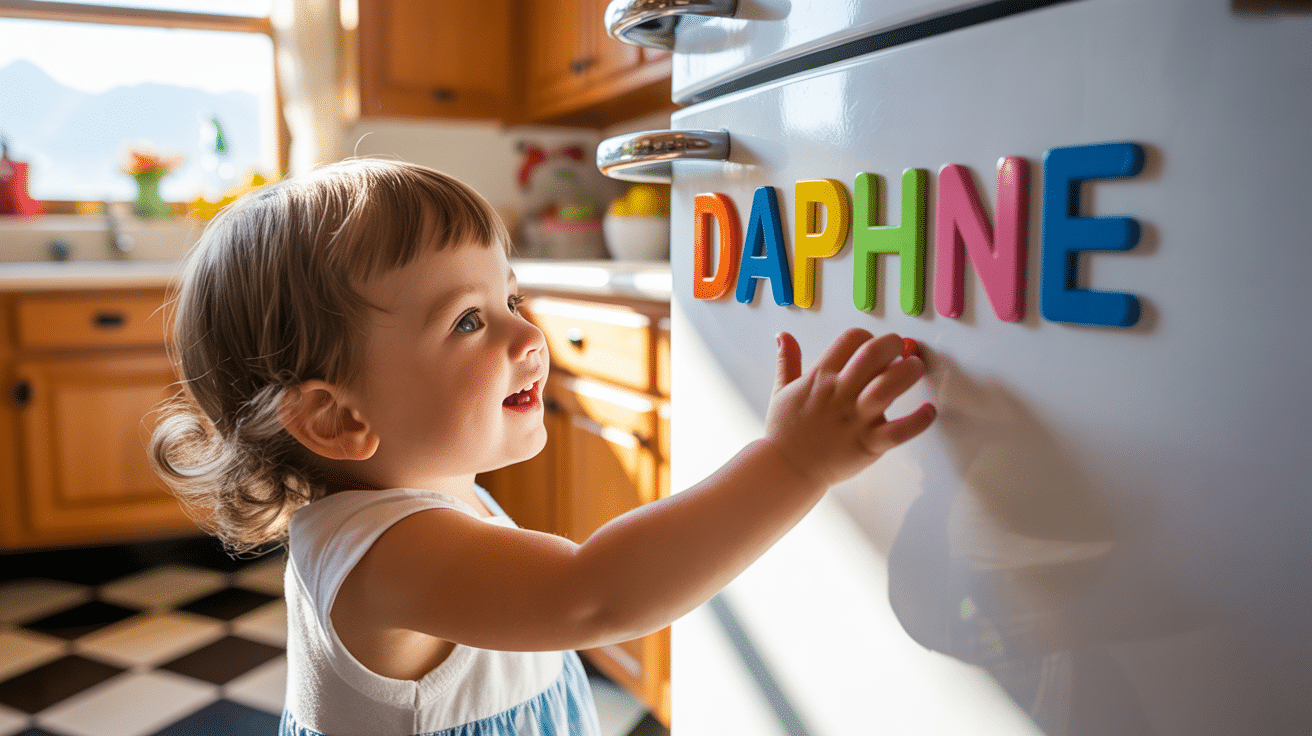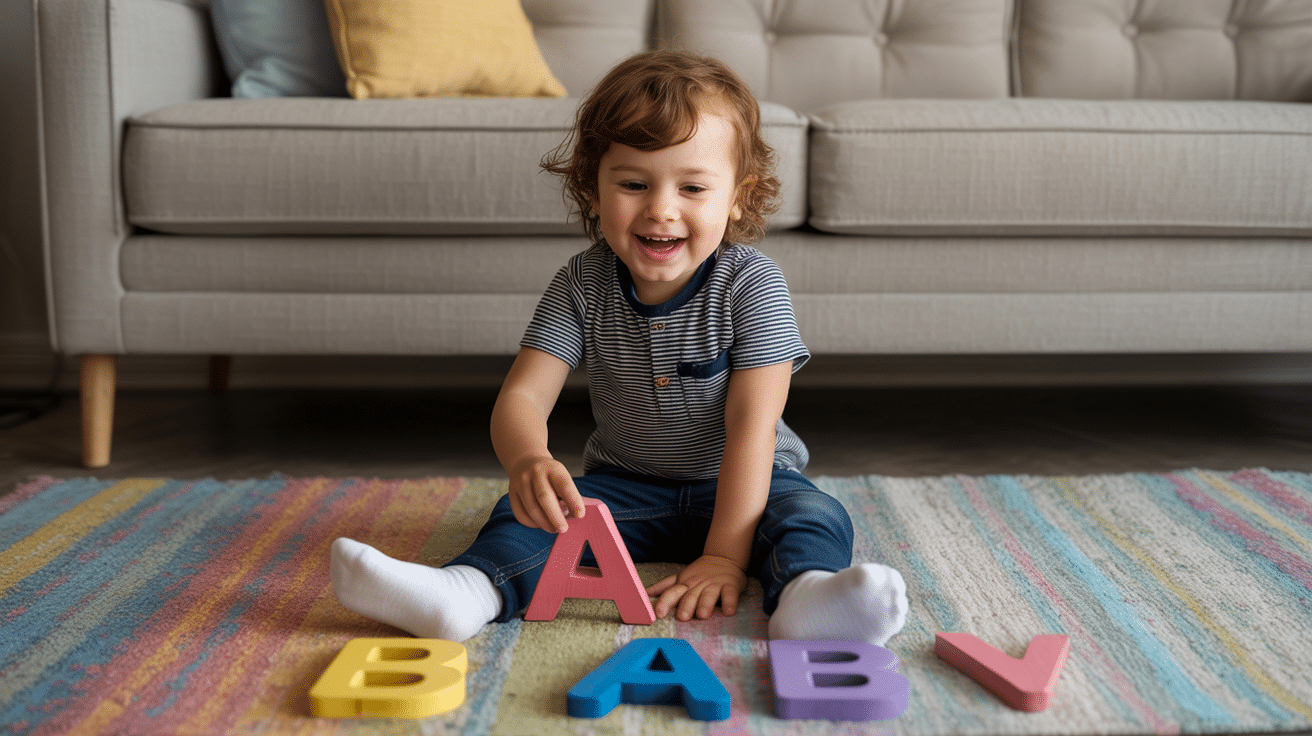Does your little one mix up their Bs and Ds? You’re not alone. Many parents notice their children struggle with letters, which can cause worry about future reading skills.
Children who play with letters build strong foundations for reading success.
This guide will help you turn letter learning into play time. The activities in this post need just basic items you likely have at home already. Your child will soon point out letters everywhere – from cereal boxes to street signs!
Let’s look at simple ways to make letter learning stick without tears or boredom!
What is Letter Recognition?

Letter recognition is the skill of knowing alphabet letters by sight. A child shows this skill when they can:
- Name a letter when they see it
- Tell the difference between letters that look alike (p, q, b, d)
- Match uppercase with lowercase versions (A with a)
- Link letters to their sounds (“M” makes the /m/ sound)
This skill grows slowly. At first, children notice that marks on paper mean something. Then they learn that these marks are special shapes called letters. Most kids start with the letters in their name.
Letter recognition activities for preschoolers focus on making learning playful. When children touch, see, build, and play with letters, they remember them better.
How to Introduce Letter Recognition to Preschoolers

Teaching the alphabet to young children works best when it is part of daily life rather than formal lessons.
Here are five ways to bring letters into your child’s world:
1. Start with their name
Children care most about the letters in their own names. Point out these special letters first, especially the first letter. Make a name puzzle or use magnetic letters to spell their name on the fridge.
2. Focus on form before sounds
Let children feel letter shapes with their fingers before teaching letter sounds. Use sandpaper letters, play-dough, or finger paint to help them connect with letter shapes through touch.
3. Choose lowercase first
While many letter recognition activities for preschoolers begin with capitals, lowercase letters appear more often in books. Teaching both is important, but lowercase letters give children a head start with reading.
4. Keep sessions short
Young children have brief attention spans. Limit letter learning to 5-10 minutes at a time. Stop before they get bored or frustrated to keep the experience positive.
5. Use multiple senses
Letters stick better when learned through different senses. Sing alphabet songs, trace letters in sand, build them with sticks, and find them in books. The more ways children interact with letters, the better they remember them.
Remember that patience matters most when teaching letters. Each child learns at their own speed, and pressure can make learning harder.
Letter Recognition Activities for Preschoolers: Fun Ways

Letter recognition activities for preschoolers don’t need to feel like work.
The following games and hands-on tasks turn what could be boring practice into playtime that children will ask to do again and again:
1. Alphabet Scavenger Hunt
Set up a scavenger hunt where preschoolers look for objects around the house or classroom that start with different letters.
It’s a fun way for them to make connections between letters and their sounds. They’ll be excited as they hunt for familiar items and learn new ones.
- What you’ll need: Paper, markers, items around the house or classroom
- Instructions: Create a list of letters and ask children to find objects starting with each letter.
2. Letter Tracing with Finger Paint
Let the children use their fingers to trace letters made out of finger paint. It’s a sensory activity that connects tactile feedback with letter recognition. The fun part is allowing them to feel the letter shapes while also associating them with the sounds.
- What you’ll need: Finger paint, paper, water
- Instructions: Write large letters on paper, and let the kids trace them with their fingers in the paint.
3. Alphabet Sorting
This activity involves sorting various objects, pictures, or letter cards into their corresponding letter piles. It encourages visual recognition and understanding of how each letter appears.
Sorting helps children understand the differences between letters and their corresponding sounds.
- What you’ll need: Letter cards, small objects, pictures
- Instructions: Mix up the letters and ask children to sort them into their correct categories.
4. Letter Bingo
Create bingo cards with letters on them, and call out the letters one by one.
When a child hears the letter, they place a marker on it. This game helps reinforce letter recognition through repetition in a competitive but fun setting.
- What you’ll need: Bingo cards, markers, letter list
- Instructions: Call out a letter, and children mark it on their bingo cards until one completes a row.
5. Letter Jump
Write different letters on the floor using tape or chalk, and have the children jump to the letter you call out. It’s a great way to combine physical activity with learning. This activity helps children associate the letters with body movement. It’s a perfect way to get kids moving while learning.
- What you’ll need: Tape or chalk, open space
- Instructions: Call out a letter and ask the children to jump to it.
6. Magnetic Letters Fun
Using magnetic letters on a board or fridge, ask the kids to identify and name them. You can also have them arrange the letters to form simple words. This activity reinforces letter recognition and helps with phonetic awareness.
- What you’ll need: Magnetic letters, magnetic board, or fridge
- Instructions: Ask children to pick a letter and name it, or arrange letters to form simple words.
7. Letter Sticker Art
Give children letter stickers to place on paper in creative designs. This lets them practice their letters while also exploring their artistic side.
It’s an enjoyable way to incorporate letter recognition into an art project.
- What you’ll need: Letter stickers, paper
- Instructions: Have children create designs with the letter stickers while saying the letter names.
8. Alphabet Puzzles
Provide preschoolers with puzzles where each piece is a letter. As they fit the pieces together, they’ll learn to recognize letters in a fun, interactive way.
Puzzles encourage fine motor skills while also helping with cognitive development. This is a great hands-on activity to reinforce letter recognition.
- What you’ll need: Alphabet puzzle
- Instructions: Have children piece together the alphabet puzzle while saying the letter names aloud.
9. Letter Recognition Songs
Sing fun songs with the alphabet or specific letter sounds. Incorporating music helps children remember letters and their corresponding sounds through repetition and rhythm. This activity is enjoyable, and the melodies make learning stick.
- What you’ll need: Music, lyrics
- Instructions: Sing songs that emphasize the letters of the alphabet and encourage kids to sing along.
10. Letter Dot Painting
Using dot markers, have children “paint” the letters of the alphabet on a page.
This provides a creative way to practice letter formation while focusing on recognition. It’s a great way to integrate art into letter learning.
- What you’ll need: Dot markers, paper, printed letters
- Instructions: Provide printed letters for children to trace and fill with dot markers.
11. Alphabet Hunt in Books
Go through a picture book with the children and search for objects that begin with specific letters. This is a fun and educational way to reinforce letter recognition.
As children find items, they practice identifying the beginning letter of each word.
- What you’ll need: Picture book
- Instructions: Ask children to find objects starting with a specific letter while reading.
12. Letter Match
Create cards with uppercase and lowercase versions of each letter. Children will match the pairs, which helps with recognizing different letter forms. This matching activity fosters both visual and tactile learning.
It encourages kids to make connections between the different forms of letters.
- What you’ll need: Uppercase and lowercase letter cards
- Instructions: Spread the cards out and have children match uppercase letters with their lowercase counterparts.
13. Letter Hunt in Rice
Fill a sensory bin with rice and hide letter beads or plastic letters.
Children will use their hands to find the letters and identify them. This sensory activity combines letter recognition with the excitement of a scavenger hunt. It’s an enjoyable way for children to practice while improving fine motor skills.
- What you’ll need: Rice, letter beads, or plastic letters
- Instructions: Bury the letters in rice and have children search for them.
14. Letter Tracing with Sand
Spread sand in a shallow tray and ask children to trace letters with their fingers.
This activity blends tactile experience with letter recognition. The feeling of the sand makes it fun and easy for children to practice letters while connecting them to the sounds they make.
- What you’ll need: Sand, shallow tray, letters
- Instructions: Children trace letters in the sand with their fingers.
15. Alphabet Stamp Art
Using alphabet stamps and ink pads, have the children stamp the letters onto paper.
As they do so, encourage them to say the letter names out loud. This activity integrates creativity with learning. It’s an exciting way to get preschoolers to engage with letters through art.
- What you’ll need: Alphabet stamps, ink pads, paper
- Instructions: Children stamp each letter and say its name aloud.
16. Letter Fishing
Set up a fishing game where preschoolers use a magnetic fishing pole to “catch” letter cards floating in a water bin. This is a fun way to practice letter recognition while incorporating fine motor skills.
The children will love the challenge of fishing for letters. It’s a simple activity that’s fun and educational.
- What you’ll need: Magnetic fishing pole, water bin, letter cards
- Instructions: Place letter cards in a water bin and let the children fish for them.
17. Letter Lacing Cards
Use lacing cards with letters printed on them. Children will thread a lace through the holes of the letters, helping to reinforce their recognition and formation.
This is a fun and relaxing way to practice letter recognition while improving fine motor skills. It also helps with hand-eye coordination.
- What you’ll need: Lacing cards with letters, string, or lace
- Instructions: Children lace the string through the holes in the letter cards.
Creating an Effective Letter Recognition Program

Planning a structured approach to teaching letters helps children learn consistently. These tips will help you create a program that works for your preschooler without turning learning into a chore:
- Choose a logical letter order instead of alphabetical (start with letters in their name).
- Teach similar-looking letters (like b/d or p/q) separately to avoid confusion.
- Use a mix of free play and guided letter recognition activities for preschoolers.
- Schedule regular but brief practice times, ideally the same time each day.
- Track progress with a simple chart to celebrate small wins.
- Connect letters to things the child already loves (dinosaurs, cars, flowers).
- Include movement games to help active learners remember letter shapes.
Remember that consistency matters more than perfection.
A few minutes daily will help your child learn more than occasional long sessions. Your enthusiasm about letters will help your little one develop a positive attitude toward reading.
The Bottom Line
Teaching the alphabet doesn’t require fancy materials or expert knowledge.
The key is making letters part of everyday fun. When children see letters as friends rather than tasks, learning happens naturally. Letter recognition activities for preschoolers work best when they connect to real life.
What letter activities have worked in your home? Share your successes and challenges in the comments below!




